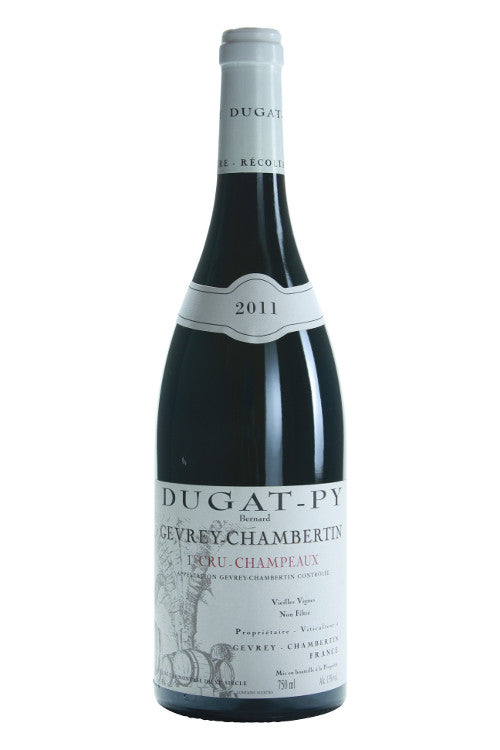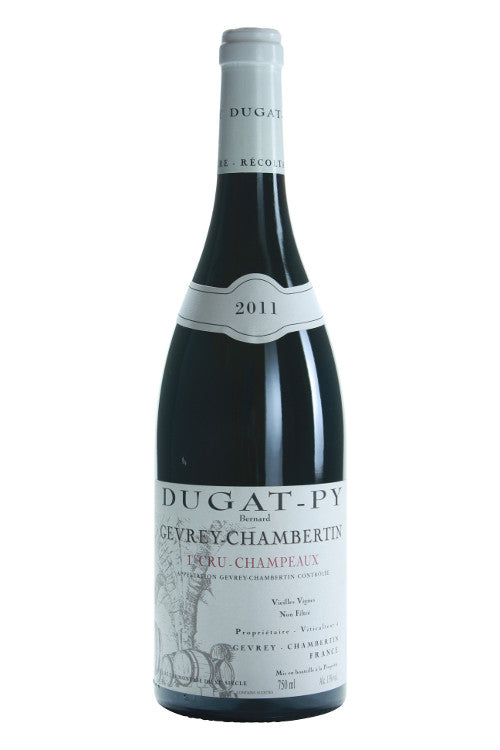1
/
of
1
Bernard Dugat-Py Gevrey-Chambertin 1er Cru Champeaux - 2011 (750ml)
Bernard Dugat-Py Gevrey-Chambertin 1er Cru Champeaux - 2011 (750ml)
Regular price
$339.99
Sale price
$339.99
Regular price
$419.99
Unit price
/
per
A ripe but more restrained nose of stone, plum and dark berry fruit liqueur scents introduces extract-rich and palate coating medium-bodied flavors that also display an intense minerality. There is a velvety mouth feel to the serious, linear and explosively long finish that displays a trace of the hallmark austerity in a young Champeaux. Terrific potential.
Burghound - 92-94 points
Burghound - 92-94 points
Availability:
1 In Stock
$25 Shipping on Orders +$299
Couldn't load pickup availability
Share :

- varietal
- Region
- Sub - Region
- Type
- Reviews
Product Review
A ripe but more restrained nose of stone, plum and dark berry fruit liqueur scents introduces extract-rich and palate coating medium-bodied flavors that also display an intense minerality. There is a velvety mouth feel to the serious, linear and explosively long finish that displays a trace of the hallmark austerity in a young Champeaux. Terrific potential.
Product Score
94
Pinot Noir is responsible for some of the world’s finest wines. Famed for producing the red wines of Burgundy and the Côte d’Or in particular, it is now widely grown in cool climates across Califonia and Oregon, and with increasing success in New Zealand. Although typically used to produce varietal wines, Pinot Noir makes a significant contribution in the wines of Champagne, where it is vinified as a white wine and blended with Cardonnay and Pinot Meunier. On the whole, fresh summer fruit of strawberries, raspberries and red cherries tend to be the identifying qualities, however richer versions express darker fruit including black cherries (kirsch), cherry cola, leather and violets to name a few.
Two hundred miles south east of Paris lies the famous and historic wine region, known in French as Bourgogne. The Cote d'Or, the heartland of the region, consists of two distinct sub-regions split on either side of the town of Beaune.The Côte de Nuits to the north, includes the famous villages of Vosne-Romanee, Gevrey-Chambertin, and Nuits-Saint-Georges and are known primarily for making red wine from Pinot Noir.Although The Côte de Beaune to the south still makes some magnificent reds (see Volnay and Pommard), white wine made from Chardonnay is the main focus. The most famous villages are Puligny-Montrachet and Meursault. Burgundy has three other important regions. The village of Chablis (exclusively Chardonnay) encompassing the region's most northerly vineyards. The Côte Chalonnaise and Mâconnais to south are quantitatively speaking more important. Agriculture is more diverse with a significant portion of the land devoted to livestock and arable farming.
With 400 hectares under vine and eight grand crus (more than any other village,) Gevrey-Chambertin is one of Burgundy’s largest but yet finest villages. Its wines are typically richer and firmer than neighbouring Chambolle-Musigny and Vosne-Romanée to the south. Gevrey’s grand crus are located together in one area at the southern end of the village bordering Morey-Saint-Denis. Chambertin, often considered the finest as with the region’s other great vineyards, is appended to the name of the village to which it belongs. Interestingly and perhaps by no coincidence, Chambertin shares a very similar soil make-up to the equally famous white wine vineyard - Le Montrachet – in the Cote de Beaune’s, with an almost identical proportion of two thirds fine earth and one third pebbles. Adjoining Clos de Beze and Chapelle just below are also considered to be just as fine, but are slightly different in style, offering more delicacy and sometimes more complex wines. Some of the villages premier crus, such as Clos St-Jacques and Cazetiers in the north west corner of the commune, are often sold for just as much the grand crus, and are quite justifiably priced. The village level wines also vary depending on where they come from. Those to the north have more grip and strength, while the southern climats tend to me more fragrant. In this instance, blending of the different vineyards allow more flexibility in producing a more complex and balanced wine.
Red wine is wine made from dark-coloured grape varieties. The color of red differs based on the grapes variety or varieties used.Interestingly, black grapes yield a juice that is greenish-white. The actual red color comes from anthocyan pigments (also called anthocyanins) from the skin of the grape (exceptions are the relatively uncommon teinturier varieties, which produce a red colored juice). Most of the production centers around the extraction of color and flavor from the grape skin.


